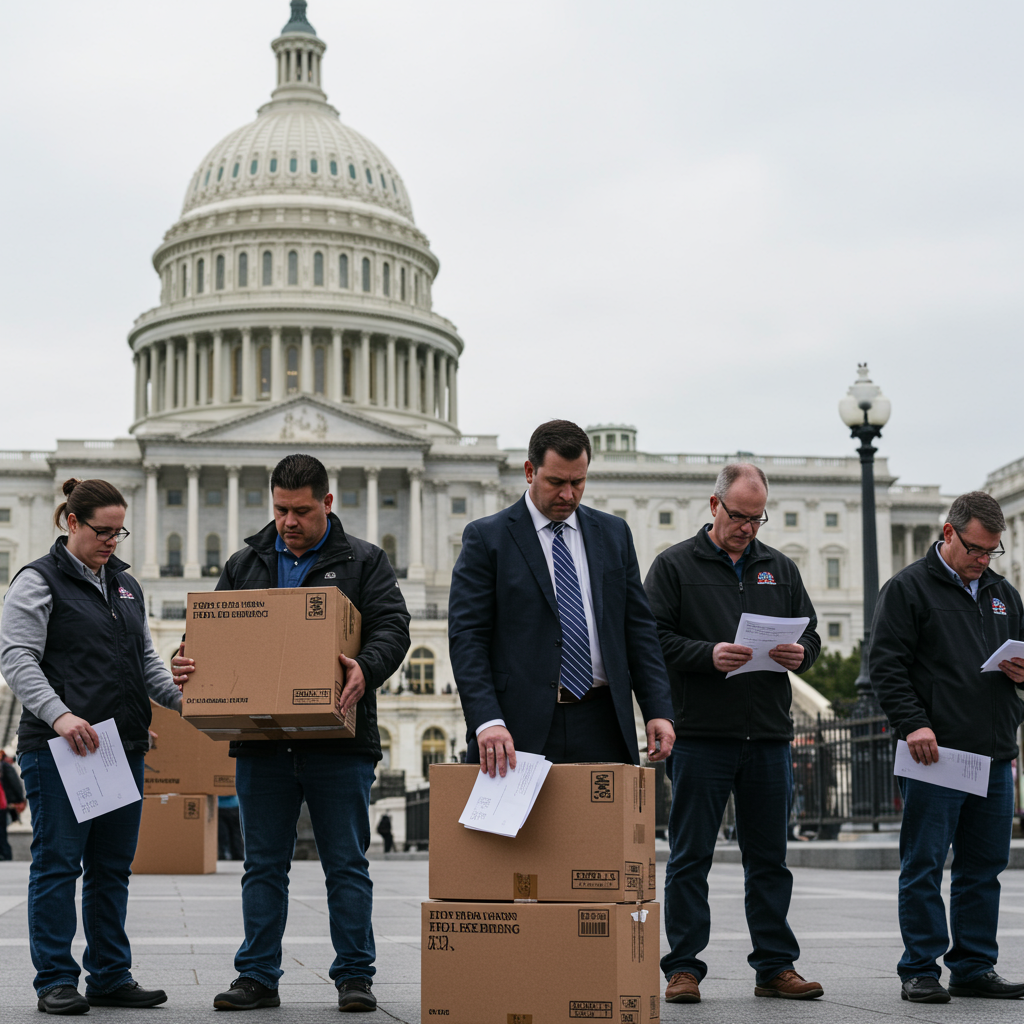As the U.S. government shutdown drags into its tenth day, the White House has initiated unprecedented mass firings of federal workers, dramatically escalating pressure on Democratic lawmakers. This aggressive move, confirmed by the Office of Management and Budget (OMB), marks a significant departure from standard shutdown procedures, threatening to permanently alter the federal workforce and deepen the already contentious political impasse in Washington. For thousands of federal employees, what typically meant a temporary furlough now translates into permanent job loss, igniting legal challenges and widespread condemnation.
Unprecedented Pressure: White House Initiates Mass Firings
On Friday, October 10, 2025, OMB Director Russ Vought announced on social media site X that “RIFs have begun,” referring to “reduction-in-force” plans. These RIFs are not the temporary furloughs federal employees usually experience during a government shutdown. Instead, they represent permanent layoffs designed to reduce the size of the federal government. This stark shift in strategy by the Trump administration aims to exert maximum pressure on Democratic lawmakers to concede in the budget negotiations. The White House had signaled this aggressive tactic even before the shutdown began on October 1, instructing all federal agencies to submit RIF plans for programs deemed inconsistent with the President’s priorities or those facing lapsed funding.
President Trump had previously warned of substantial job cuts if the shutdown continued. He stated that many of these positions would “never come back,” emphasizing the permanence of these actions. This strategy significantly escalates an already toxic political dynamic. Unlike temporary furloughs, where workers are typically reinstated with back pay once a shutdown ends, these firings mean a definitive end to employment for many, stripping the government of critical expertise and stability.
Over 4,000 Jobs on the Line Across Key Agencies
Court filings from the OMB indicate that well over 4,000 federal employees are slated for termination, though the situation remains “fluid and rapidly evolving.” These federal worker firings are concentrated in departments providing essential public services. The Treasury Department faces the most severe impact, set to lose over 1,400 employees. The Department of Health and Human Services (HHS) will see over 1,100 layoffs. The Education Department and the Department of Housing and Urban Development (HUD) are each projected to lose more than 400 staffers. Additionally, hundreds more employees are being cut from the Departments of Commerce, Energy, and Homeland Security (DHS), as well as the Environmental Protection Agency (EPA).
The Education Department confirmed new layoffs, particularly affecting almost all employees below the director level at the Office of Elementary and Secondary Education. Notices of firings have also been issued at the Cybersecurity and Infrastructure Security Agency (CISA) within DHS, an agency that has been a frequent target of criticism from the administration over its work countering misinformation related to the 2020 election and COVID-19. DHS stated these specific layoffs were “part of getting CISA back on mission.” Federal health workers within HHS are also being terminated, though specific numbers were not immediately released. An EPA spokesperson attributed their layoffs directly to Democrats’ refusal to reopen the government, intensifying the blame game.
Political Strategy: Targeting “Democrat-Oriented” Areas?
President Trump made explicit comments regarding the targeting of these federal worker firings. Speaking in the Oval Office, he stated that the job cuts would be “focused on Democrat-oriented areas.” He characterized many federal employees as “people that the Democrats wanted, that, in many cases, were not appropriate.” This highly politicized framing suggests a deliberate effort to reshape the federal bureaucracy while simultaneously pressuring political opponents. The administration’s move to initiate permanent job cuts, rather than temporary furloughs, reinforces the aggressive nature of their government shutdown pressure tactic.
This move goes far beyond the typical scope of government shutdowns, historically used as leverage for budget negotiations. The White House’s directive to agencies before the shutdown to submit RIF plans for programs “not consistent with the President’s priorities” or unfunded programs further underscores this strategic, politically motivated approach to workforce reduction. The intent appears to be not just to end the shutdown but to permanently alter the landscape of federal service.
Legal Battles and Bipartisan Condemnation
The American Federation of Government Employees (AFGE), a major union representing federal workers, has swiftly responded with legal action. They filed a lawsuit asking a federal judge to halt the firings, calling the administration’s actions an “abuse of power designed to punish workers and pressure Congress.” AFGE President Everett Kelley condemned the firings as “disgraceful,” asserting they illegally hurt workers who provide critical services nationwide. Democrats, initially skeptical of the administration’s bluff, have accused the White House of callousness and illegal conduct. Senator Chuck Schumer placed the blame squarely on Trump and Vought, labeling their actions “deliberate chaos” chosen to harm workers who protect the country and respond to disasters. Senator Patty Murray also stated that the shutdown does not grant the administration “new, special powers” to lay off workers.
Even some prominent Republicans voiced criticism. Maine Senator Susan Collins, chair of the powerful Senate Appropriations Committee, “strongly opposed” Vought’s attempt to permanently lay off furloughed workers, though she attributed the shutdown to Senate Minority Leader Chuck Schumer. Alaska Senator Lisa Murkowski called the announcement “poorly timed” and “yet another example of this administration’s punitive actions toward the federal workforce.” These remarks indicate a degree of discomfort within Trump’s own party regarding the severity and political nature of the firings, suggesting that the government shutdown pressure tactics might be backfiring in some quarters.
Stalled Negotiations and Long-Term Impact
On the tenth day of the shutdown, the halls of the Capitol remained quiet, with both the House and Senate out of Washington, signifying a deep legislative impasse. Talks to end the shutdown are described as “almost nonexistent.” Senate Republicans have repeatedly attempted to sway centrist Democrats to vote for a stopgap bill to reopen the government, but Democrats have steadfastly refused, demanding a firm commitment to extend healthcare benefits. Senate Majority Leader John Thune continues efforts to peel away centrist Democrats, asserting, “It’s time for them to get a backbone.”
The broader implications of these federal worker firings extend far beyond the immediate political struggle. The Partnership for Public Service, a nonpartisan organization tracking federal service, warns that these “unnecessary and misguided reductions in force will further hollow out our federal government, rob it of critical expertise and hobble its capacity to effectively serve the public.” This concern is amplified by the fact that over 200,000 civil servants have already left federal service since the start of the current administration due to earlier firings, retirements, and deferred resignations. These new layoffs will exacerbate the loss of institutional knowledge and operational capacity, potentially impacting everything from national security to public health and economic stability. The long-term damage to the federal workforce and the government’s ability to deliver essential services could be substantial and difficult to reverse, even after the current political standoff concludes.
Frequently Asked Questions
What is a “reduction-in-force” (RIF) in the context of a government shutdown?
A “reduction-in-force” (RIF) is a permanent layoff of federal employees, distinct from a typical furlough during a government shutdown. Traditionally, during a shutdown, federal workers are temporarily furloughed, meaning they are placed on unpaid leave but are expected to return to their jobs once funding is restored, often with back pay. In contrast, RIFs involve the permanent elimination of positions and termination of employment, signifying a deliberate and lasting reduction in the federal workforce. The Trump administration’s decision to implement RIFs marks an unprecedented escalation during a government shutdown.
Which federal agencies were most impacted by the mass firings during the shutdown?
The mass firings initiated by the White House during the government shutdown significantly impacted several key federal agencies. The Treasury Department faced the largest cuts, with over 1,400 employees slated for termination. The Department of Health and Human Services (HHS) was set to lose over 1,100 employees. Both the Education Department and the Department of Housing and Urban Development (HUD) were each expected to shed over 400 staffers. Additionally, hundreds more employees were being fired from the Departments of Commerce, Energy, and Homeland Security (DHS), including its Cybersecurity and Infrastructure Security Agency (CISA), and the Environmental Protection Agency (EPA).
What was the White House’s stated rationale for initiating permanent firings instead of furloughs?
The White House’s rationale for initiating permanent firings (RIFs) instead of temporary furloughs was primarily to exert greater political pressure on Democratic lawmakers to end the government shutdown and to permanently reduce the size of the federal government. President Trump stated the firings would target “Democrat-oriented areas” and employees he considered “not appropriate,” implying a strategic move to “clear out dead wood, waste, and fraud.” The administration had also directed agencies before the shutdown to submit RIF plans for programs not aligned with the President’s priorities, signaling a long-term goal of reshaping the federal bureaucracy.
In conclusion, the mass federal worker firings initiated by the Trump administration during the government shutdown represent an unprecedented and aggressive escalation of a political standoff. This departure from traditional furloughs to permanent layoffs for over 4,000 employees highlights a deliberate strategy to exert maximum pressure on Democratic lawmakers while simultaneously attempting to reshape the federal workforce. With legal challenges mounting from federal employee unions and bipartisan condemnation emerging from Capitol Hill, the crisis deepens, leaving thousands without jobs and threatening the core capacity and expertise of the U.S. government to serve the public. The political impasse remains unbroken, with severe, long-lasting consequences for federal employees and public services.



